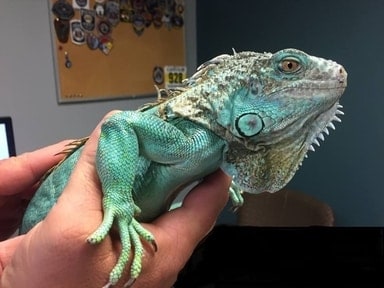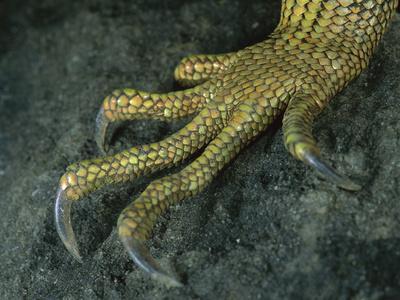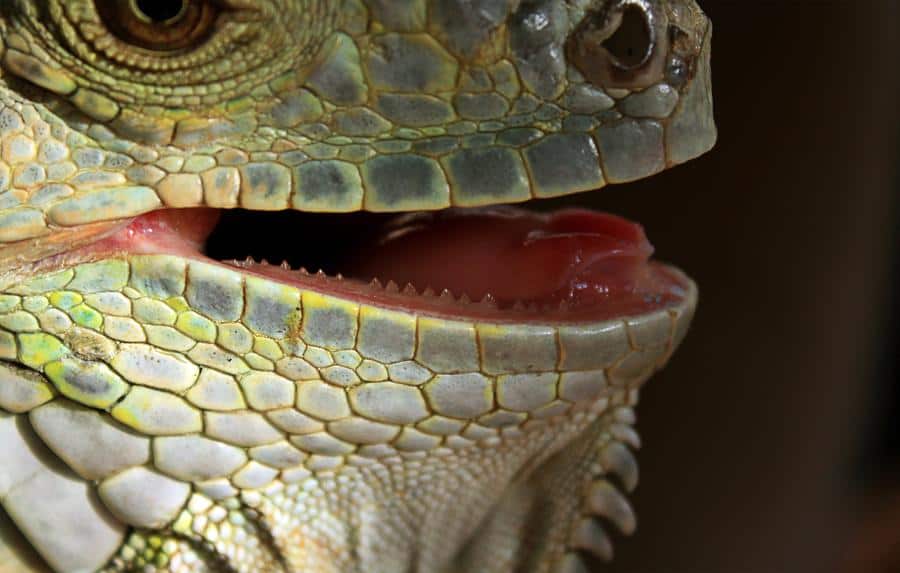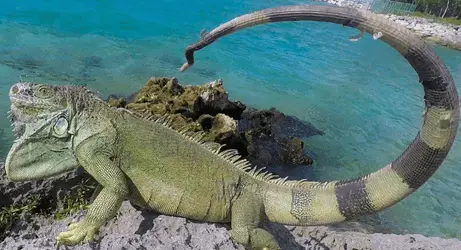Are iguanas dangerous? This is an important question that many aspiring owners have. I did a lot of research and will share my findings with you today.
Iguanas are beautiful, fierce-looking animals. Therefore, it’s not very surprising that so many people wonder if they are dangerous animals. If you’re considering getting a pet iguana then it’s good that you’re doing the required research before getting one so that you know what you’re getting into. In this pet owners’ guide, I’m going to go over whether or not these are dangerous animals so that you can make an informed decision on whether or not this is the right pet for you.

I will cover many things to once and for all answer the question: are iguanas dangerous? I will cover subjects ranging from their temperament to the dangers these creatures pose to potential owners. I will also go over how you can spot aggressive iguanas so you know when they are dangerous and the reasons why they display aggressive behavior.
It should be noted by anyone who’s considering getting a pet iguana that they can be dangerous animals. They have an incredibly strong tail that they can use in a whip-like manner, sharp serrated teeth, and strong claws. However, they generally only use them in self-defense and usually aren’t very aggressive towards humans if they’ve been properly raised. Also, they have salmonella bacteria on their skin, which can be very dangerous to humans so make sure to wash your hands often when handling an iguana.
To learn more about the potential dangers of these interesting reptiles, keep reading.
Iguanas are wild animals and can be dangerous
All pets come with inherent dangers (except goldfish maybe), there’s no denying it.
A dog can bite you, a cat can scratch you and a snake can strangle you. However, there’s a very real difference between having a dog or a cat as a pet and having a reptile, like an iguana, as a pet.
Let’s take dogs as an example. They were domesticated 15,000 years ago. Therefore, they’ve had thousands of years to adapt to becoming pets and are perfectly adapted to living with us. They’ve even had enough time to evolve alongside humans to become the perfect domesticated pets. They enjoy the presence of humans and when trained well, a dog will never attack its owner.
Iguanas, in contrast, have only been introduced as pets very recently. Therefore, in captivity, they are still very similar to wild iguanas, and this is reflected in their behavior. They have not had the time to adapt and evolve alongside humans to become their companions.
For that reason, they feel more stress when in the presence of humans. This can get better if you spend enough time with them and socialize them to become more comfortable with you, but it will never be the same as with a purely domestic animal like a dog.
Does this mean though that you cannot safely keep an iguana as a pet? No, it doesn’t. If you treat them with the respect they deserve and remember that they’re wild animals and not domesticated animals like a dog then I believe you can keep them as a pet without any real danger to the iguana or yourself.
You do have to understand these things before getting one as a pet though, otherwise, you might get frustrated by their behavior and unfairly blame the iguana when it’s acting out. Try to be patient and understanding with them and remind yourself that they’re acting upon instinct and their nature.
Temperament – do iguanas bite or attack?
Generally speaking, iguanas aren’t aggressive pets when properly trained and will not actively try to harm their owner. If you’d like to learn how to properly train them, this is a good book that will teach you everything you need to know.
However, they do not always have the same temperament.
Some of them are more laid back and mellow while others display more aggressive behavior. In general, males tend to be more aggressive than females, especially in the breeding season.
Nevertheless, all iguanas do have sharp teeth, claws, and a powerful tail that they can all use to attack you. The damage they can inflict with these should be respected and not be underestimated. You have to keep in mind that they are in essence wild animals with a powerful kit of defensive tools.
Even the most well-trained iguanas can lash out from time to time if they feel like they’re being threatened, and this is completely normal. After all, they’ve still got their wild animal instincts and their behavior reflects that. The reasons why they get aggressive or hurt you can vary, but here are the most common ones:
Fear
When animals are scared, it’s very common for them to either run away or attack. This is called the fight or flight response, and it’s even present in humans. Since iguanas can’t really run away when they’re in their cage, their only other option to respond to fear is to fight. This can manifest itself in a bite, scratch, or even a tail whip.
Always make sure not to scare your iguana when you’re handling them or picking them up from their cage. Make them aware of your presence and do not come out of nowhere to grab them. It’s good to talk to them so that they know you’re there. Also, refrain from making too many sudden movements.
Accidents happen
It can also happen that your iguana hurts you by accident.
For instance when you’re feeding them. If this happens, it’s nothing to worry about. If you’re sure that they hurt you by mistake and not on purpose, just forgive them and move on.
Breeding season
The most common reason why iguanas get aggressive is because of the breeding season. Males especially get aggressive during this time because in the wild they’re competing for females during this time. In captivity, they can view you (their owner) as a competitor and thus might lash out and attack you.
The breeding season in the wild lasts for about 30 days. However, in captivity it’s different. Research is unsure why, but for some reason, the breeding season seems to last longer in captivity. It can last anywhere from 1 to 4 months. During this time, be extra vigilant when handling your iguana to avoid getting hurt.
Try to be understanding and have patience with them. This is just their natural behavior and there’s nothing they can do about it.
Color triggers
It sounds strange, but there are reports that iguanas get angry by seeing certain colors. However, I’m not sure how true this is.
I’m sure you’ve heard the story of bulls getting angry at the color red. Many people think that this is true, but it’s not. Mythbusters did an interesting experiment where they tested to see if bulls really get mad at the color red, and it turned out to be false.
There’s also no other evidence of animals getting mad at certain colors so I wouldn’t put too much weight on these statements.
If you do notice that your iguana seems to get more aggressive around certain colors try your best to avoid these colors around them.
How to spot signs of aggression
Usually, iguanas do not attack out of nowhere. There are signs that you can see well in advance that it’s not the right time to approach them. However, in order to spot the signs of aggression you need to know what to look for.
The main way you can spot an iguana that’s showing signs of aggression is when they walk on straight legs, bob their head, and generally have a sort of “evil” look in their eyes. If you notice this kind of behavior, it’s best not to try to pick them up or approach them because you might get hurt.
They also twitch their tail as a show of aggression.
Dangers of keeping iguanas as a pet
Iguanas can be dangerous, especially during breeding season or when they feel threatened. They will defend their territory and can hurt you. Let’s take a look at the most common ways they attack and defend so that you can be prepared for what they might do.
They might scratch
Iguanas have very strong, long, and sharp claws. Take a look at the image below and you’ll see why these claws can easily be used as a weapon.

In the wild, they mainly use these claws to climb or as a method of defense. For that reason, if your iguana feels threatened by you, it might use its claws to defend itself.
Iguanas can bite
The most dangerous thing about iguanas is their bite. Not only because of the wound it inflicts, but also because they have salmonella bacteria in their mouth.
If you do not take proper care of an iguana bite it can easily get infected.

They do not have huge teeth, but the teeth they have are very sharp and serrated. This means they have sawlike teeth.
They have between 80 and 120 of these serrated teeth in their jaws. They are herbivorous creatures by nature so they do not use these teeth to attack prey but rather to grasp and tear down the plants in their diet.
Nevertheless, they can inflict a lot of damage when they’re being used defensively and the wound these teeth inflict will usually require stitches and medical attention.
Always make sure that you’re careful not to get bitten.
Their tail
Another weapon the iguana has is its tail. They can use it like a whip and can inflict blunt force damage with it.
The impact of their tails should not be underestimated. Getting hit by an iguana tail can seriously hurt and do a lot of damage to you.

Their tail can grow up to 3 feet long so it has quite a long reach.
Risk of salmonella
Iguanas have a fourth invisible weapon: salmonella. Unlike their claws, teeth, and tail this danger is hidden and that makes it all the more dangerous.
Salmonella is a bacteria that is very dangerous to humans.
This bacteria is present on the iguana’s skin, mouth, and feces. Luckily salmonella doesn’t harm your iguana but it can cause serious harm to their owners.
Salmonella can even result in death in individuals with a weak or compromised immune system.
Since they carry the salmonella bacteria directly on their skin they spread it all over their enclosure. This means you have to be careful when handling them or their cage and clean yourself frequently when interacting with them directly or indirectly.
Remedying and preventing the dangers of iguanas
Every iguana owner of course wants to avoid getting bitten, scratched, or tail whipped by these fearsome lizards, but that’s not always possible.
Let’s go over some ways to minimize the risk of being attacked by them and what to do if it does happen so you’re prepared for the worst.
How to prevent bites
In order to prevent your iguana from biting you, you should make sure that he feels comfortable at all times. If they do not feel threatened, they seldom bite because there is no reason for them to do so. You should also take note of the signs your iguana shows when they’re under stress. We have mentioned some of the signals of aggression you should pick up on earlier.
If they’re about to bite they will make themselves big, lean forward, judge the distance between you and them, and bob their head.
If you’re noticing these things, get to a safe distance to prevent getting bitten. You should also pay attention to their dewlap, which is a flap of skin under their chin. Most iguanas will inflate it with air when they’re feeling threatened to make themselves look bigger and scarier.
To prevent bites the best thing to do is to wear gloves when handling them. There are special gloves for handling lizards that you can buy online in shops like Amazon.
I highly recommend you wear these gloves, especially when you’re new to dealing with iguanas.
What happens if an iguana bites you?
However, if you’ve missed the signs or if your iguana didn’t give you any and you received a bite, make sure to not yank your hand away. This will only increase the damage.
Usually, they will let go by themselves, but if they do not the best thing to do is hold them upside down or spray their face with water. This confuses them and usually causes them to let go of your flesh.
If you’ve been bitten, you should vigorously rinse the wound with water and disinfect it. Afterward, seek medical care.
How to prevent scratches
Scratches are almost unavoidable. It happens at some point to almost any iguana owner. Their claws are very sharp by nature and since they use them to hang on to surfaces they will most likely do the same to your skin.
This can be quite painful. However, the gloves that I’ve mentioned before for preventing bites of course also work for preventing scratches.
You can also trim their claws. This makes them much less damaging and it doesn’t harm them. It makes handling them a lot easier and less stressful. If you’d like to learn how to trim their claws, here’s a good guide.
They will not always like getting their claws trimmed, but over time they will get used to it and be more relaxed when you do it.
Most veterinarians recommend you trim your iguana’s claws once a week when they’re younger (under 2 years old). The older they get the slower their claws will grow so the less often you will have to trim their claws.
What to do if you get scratched
If you get scratched make sure to properly clean any wounds that the scratch has inflicted on you. Do this by using a lot of water and disinfectant.
You definitely do not want bacteria to start growing in the wound because then it’ll get infected and you’ll be in trouble.
Usually scratches from iguanas will not require medical attention, but if you feel like something is wrong never hesitate to seek help.
How to prevent getting tail whipped
If your iguana feels trapped he’s very likely to hit with his tail, especially when you’re behind him. Take note of the same aggression indicators that I’ve mentioned previously so you know what to look out for. Since their tail can grow to be very long they can hit you from pretty far away so you’ve got to be a safe distance away if they’re getting angry.
You should also make sure to never grab them by their tail. Not only do they not like this, but they can also drop their tail!

Some lizards like iguanas drop their tail when they feel like they’re stuck and can’t escape any other way.
They’re miraculous creatures, and their tail will grow back in time but it will take quite a while. It can take anywhere from 2 months to a whole year for the tail to grow back.
The speed of the tail growing back depends on its age. Younger iguanas grow it back faster than older ones.
What to do if you get tail whipped
Getting tail whipped hurts, but there’s relatively little risk attached to it. Usually, the tail is used for blunt force hits and does not penetrate the skin. For that reason, there’s no wound for the bacteria to enter and spread infection.
You should still clean the spot where your iguana has hit you because of the aforementioned salmonella on their skin but medical attention is rarely necessary.
If your iguana has hit you with its tail the damage depends on how hard it hit.
If they hit with full force it’s going to hurt a lot more than if they held back.
How to prevent getting salmonella from your iguana
I’ve briefly touched on the fact that iguanas have salmonella on their skin. This is the case for all iguanas and there is no way to get rid of this. It’s just a part of who they are.
However, having said that, the fact that they carry this dangerous bacteria on their skin does mean that you have to take extra precautions. You definitely should not take this bacteria lightly because even though you can’t see it, it poses more of a threat than anything else when it comes to handling iguanas.
First off, I would suggest you have a bottle of hand sanitizer close to their cage. That way you can immediately rinse your hands after you’ve touched them and don’t risk accidentally touching other surfaces while the bacteria is still on your hand. You’ll also prevent accidentally touching your eyes, nose, or mouth before you’ve cleaned your hands.
Since the bacteria live on their skin, they spread it to their cage too. The same thing about disinfecting your hands applies when you’re done cleaning their cage. Also, if you’re going to clean their cage, never do it anywhere near where you’re cooking, storing, or preparing food. That way you don’t risk accidentally spreading the salmonella bacteria to your own food.
The best way to prevent getting contaminated with the bacteria that live on your iguana’s skin is to practice proper hygiene. If you do, there shouldn’t be much to worry about. A lot of chicken also contains salmonella and we handle that just fine as long as we wash our hands properly.
Are iguanas dangerous to dogs?
Iguanas generally do not get along very well with dogs and it’s best to keep them separate.
Conclusion
So, let’s recap and sum everything up so we can finally give a proper answer to the question: are iguanas dangerous? Iguanas can be dangerous. They can bite, scratch, and whip you with their tail but will only do so if they feel threatened or trapped. In addition, salmonella lives on their skin which can make you sick. However, with proper care, handling, and training, keeping them as a pet can be a safe and very rewarding experience.
Always make sure to have plenty of disinfectant at home if you decide to become the owner of an iguana because you’ll definitely need it at some point. It will help you treat bites, and scratches, and wash off the salmonella.
I hope this breakdown of whether or not iguanas are dangerous was not too doom and gloom. I’m simply trying to give a realistic overview of the dangers that are present when keeping a large lizard, like the iguana, as a pet because there definitely are risks attached to it. It’s better to be prepared for the dangers that might come than having to face them blindly.
Nevertheless, if you take good care of them I’m sure you can have a very rewarding and fulfilling experience taking care of one of these lizards.
If there’s anything you think I’ve missed in this article that you would like me to add, feel free to leave a comment down below!
- How Long Do American Eskimo Dogs Live? Important Factors and Care Tips - September 29, 2023
- Do American Bulldogs Need Grooming? Essential Tips and Care Guidelines - September 29, 2023
- Do Bengal Cats Enjoy Playing? Essential Tips for Keeping Them Active - September 29, 2023